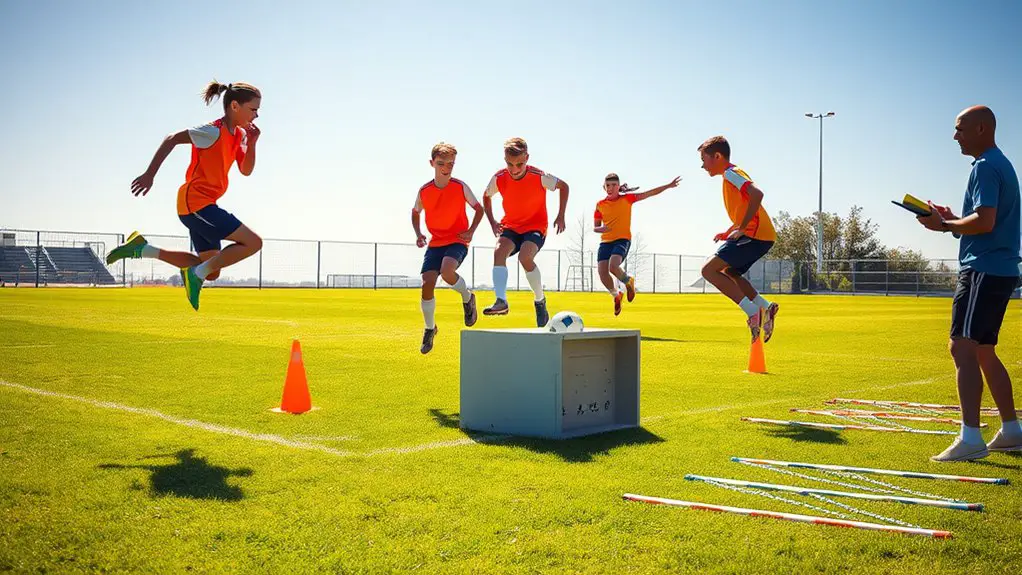If you want to improve your jumping ability for volleyball, focus on box jumps, depth jumps, and plyometric lunges. Box jumps enhance explosive power, while depth jumps boost reactive strength. Plyometric lunges increase agility and leg strength. Don't forget single-leg jump drills for balance and tuck jumps to enhance your vertical leap. Combining these drills will elevate your performance on the court. Discover more effective strategies to maximize your training and gameplay.
Box Jumps for Explosive Power
When you're looking to enhance your explosive power on the volleyball court, box jumps are an excellent drill to incorporate into your training routine. This exercise not only builds strength but also improves your agility and coordination, essential for quick movements and powerful jumps.
To get started, find a sturdy box or platform at a height that challenges you without compromising your form. Stand with your feet shoulder-width apart and engage your core. As you jump, use your arms to propel yourself upward, landing softly on the box with bent knees.
Aim for multiple sets, gradually increasing the height as you progress. Your goal isn't just to jump high; it's about mastering the technique and rhythm. Incorporating box jumps into your regimen will help you break free from limitations, releasing your inner athlete and giving you the confidence to soar on the court. Additionally, box jumps engage fast-twitch muscle fibers, which are crucial for developing explosive power during athletic activities.
Depth Jumps for Reactive Strength
To improve your reactive strength, depth jumps are a fantastic drill to add to your volleyball training. This drill focuses on the quick shift from landing to jumping, enhancing your ability to respond explosively. Start by standing on a sturdy platform, stepping off, and landing softly on your feet. As soon as you touch the ground, jump as high as you can. It's all about minimizing ground contact time, so stay light and quick.
Incorporate depth jumps into your routine a couple of times a week, aiming for 3 to 5 sets of 5 to 10 reps. Make sure you're warmed up and ready to go; you want to maximize your performance and reduce injury risk. With consistent practice, you'll notice improvements in your vertical leap and overall agility on the court. Embrace the challenge, and watch your game elevate to new heights! Additionally, depth jumps improve reactive strength and are crucial for developing explosive movements in athletes.
Plyometric Lunges for Agility
Building on the explosive power gained from depth jumps, plyometric lunges can further enhance your agility on the court. These dynamic movements not only improve your leg strength but also train your body to react quickly, which is vital during fast-paced rallies. To perform a plyometric lunge, start in a standing position, then step forward into a lunge. As you push back up, explosively switch your legs, landing in a lunge with the opposite foot forward.
Focus on maintaining control and balance while maximizing your jump height. Incorporate this drill into your routine a few times a week, aiming for three sets of 10 to 15 repetitions. You'll notice an increase in your ability to change directions swiftly, making you more unpredictable to your opponents. Additionally, these lunges promote core stability, which is essential for maintaining balance during quick movements. So, release your potential and let those plyometric lunges elevate your game!
Single-Leg Jump Drills for Balance
While you may focus on explosive power and agility, incorporating single-leg jump drills into your training routine is crucial for developing balance. These drills enhance your stability, helping you control your movements during gameplay. Start with single-leg hops, where you jump forward or sideways on one leg, landing softly and maintaining your balance.
Gradually increase the height or distance of your jumps as you gain confidence. You can also try single-leg box jumps, which not only challenge your balance but also build strength in your legs. Remember to switch legs to guarantee balanced development.
Integrating these drills into your routine boosts your performance on the court by enhancing your ability to react quickly and maintain control. As you practice, you'll find that improved balance allows for more freedom in your movements, empowering you to play with confidence and agility. Additionally, enhanced stability from core strengthening exercises can greatly benefit your overall performance. Embrace the challenge and enjoy the journey!
Tuck Jumps for Vertical Leap Enhancement
Tuck jumps are an effective way to enhance your vertical leap, as they focus on explosive power and core strength. To perform a tuck jump, start in a standing position with your feet shoulder-width apart. Bend your knees slightly, then leap upward, bringing your knees toward your chest while tucking your arms in. Land softly, absorbing the impact with your knees slightly bent to protect your joints.
Incorporate this drill into your routine two to three times a week. Aim for three sets of 8-12 repetitions. As you progress, challenge yourself by adding height or speed. Tuck jumps not only improve your vertical leap but also boost your overall agility and coordination, essential for volleyball. Additionally, incorporating plyometrics exercises into your training can further enhance your explosiveness on the court.
Embrace this drill, and you'll feel the freedom of soaring higher on the court, giving you that competitive edge. So go ahead, take the leap, and watch your performance skyrocket!
Frequently Asked Questions
How Often Should I Practice Jumping Drills Each Week?
Practice makes perfect, they say. You should aim for at least three to four times a week. This frequency keeps your skills sharp while allowing your body to recover and grow stronger, giving you the freedom to excel.
What Is the Ideal Warm-Up Routine Before Jumping Drills?
Before jumping drills, you should warm up with dynamic stretches like leg swings and lunges, followed by light jogging. This'll increase your heart rate and prepare your muscles, helping you jump higher and prevent injuries.
Can I Perform These Drills Indoors or Outdoors?
Did you know that over 75% of athletes prefer training outdoors for fresh air? You can definitely perform these drills indoors or outdoors, so choose whatever setting makes you comfortable and inspires your practice!
What Are the Signs of Overtraining in Jumping Drills?
If you're pushing too hard, you might notice fatigue, decreased performance, irritability, or persistent soreness. It's essential to listen to your body and take breaks when needed to avoid burnout and keep enjoying your training.
Are There Specific Stretches to Improve My Jumping Ability?
You're not just looking to bend like a pretzel, are you? For jumping, focus on dynamic stretches like lunges and leg swings. They'll add some spring to your step, freeing you from gravity's grasp!




